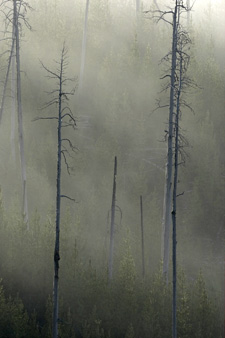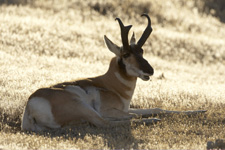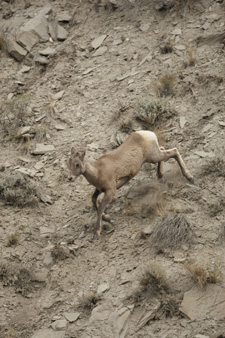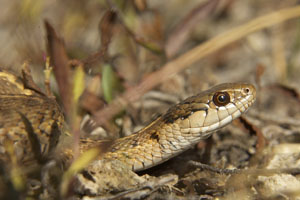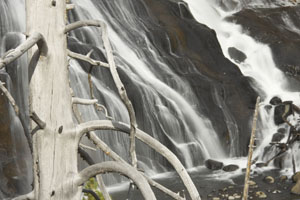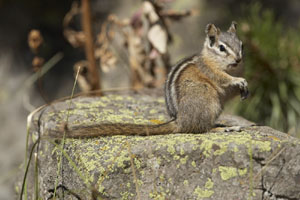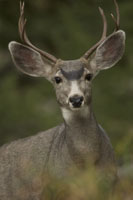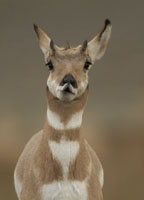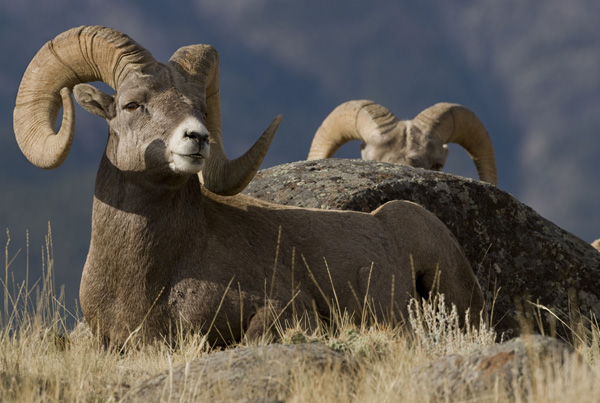

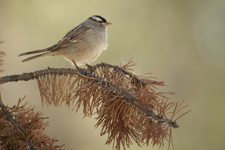 This year's trip marks
our 19th year of doing photo tours to Yellowstone and already
I'm anxious to write, next year, that we've just completed our
20th year! Well, that's a year away, but it may indicate the excitement
and enjoyment we experience each year, and illustrate the fact
that we are never bored or tired of this great wildlife national
park. In almost 20 years, we've certainly seen changes, and this
year that biggest change was the rarity of elk. We saw fewer than
we have in the past, but we still obtained photos, and certainly
observed, of the annual elk rut.
This year's trip marks
our 19th year of doing photo tours to Yellowstone and already
I'm anxious to write, next year, that we've just completed our
20th year! Well, that's a year away, but it may indicate the excitement
and enjoyment we experience each year, and illustrate the fact
that we are never bored or tired of this great wildlife national
park. In almost 20 years, we've certainly seen changes, and this
year that biggest change was the rarity of elk. We saw fewer than
we have in the past, but we still obtained photos, and certainly
observed, of the annual elk rut.
 In 'Decade of the
Wolf,' the story of the first ten years in Yellowstone's wolf
reintroduction program, the authors, Gary Ferguson and Douglas
Smith note that in 1968 the northern elk herd in Yellowstone had
been culled by government hunters to a low of 4,000 elk, in response
to the the severe over-grazing caused by an elk herd free of predators.
While we've heard somewhat confusing figures about elk numbers,
in terms of total population and the northern herd, which are
exposed to hunting and to wolves, the elk population has decreased.
Hunters and ranchers (I'm generalizing, here) blame the wolves,
while biologists (again, generalizing) cite previous over-allotment
of elk hunting tags, drought, and predation of elk calves in spring
by grizzlies. The truth may lie somewhere between all the opposing
views, but one fact really shouldn't be disputed, and that's that
wolves were, and now are again, a part of the Yellowstone ecosystem
and that whatever the elk numbers are now, those numbers probably
more accurately reflect the true carrying capacity of elk in a
changing world.
In 'Decade of the
Wolf,' the story of the first ten years in Yellowstone's wolf
reintroduction program, the authors, Gary Ferguson and Douglas
Smith note that in 1968 the northern elk herd in Yellowstone had
been culled by government hunters to a low of 4,000 elk, in response
to the the severe over-grazing caused by an elk herd free of predators.
While we've heard somewhat confusing figures about elk numbers,
in terms of total population and the northern herd, which are
exposed to hunting and to wolves, the elk population has decreased.
Hunters and ranchers (I'm generalizing, here) blame the wolves,
while biologists (again, generalizing) cite previous over-allotment
of elk hunting tags, drought, and predation of elk calves in spring
by grizzlies. The truth may lie somewhere between all the opposing
views, but one fact really shouldn't be disputed, and that's that
wolves were, and now are again, a part of the Yellowstone ecosystem
and that whatever the elk numbers are now, those numbers probably
more accurately reflect the true carrying capacity of elk in a
changing world.
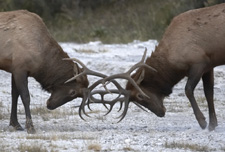 Yellowstone's wolves
have been blamed for a decrease in elk, but that same decrease
has prompted regeneration of formerly heavily browsed habitats.
Aspens and cottonwoods that were, just a few years back, only
represented by mature or aged trees are now seen as saplings -
elk are not eating all of the seedlings! Wolves compete with coyotes,
and coyote numbers - once one of the highest concentrations in
all of North America - certainly appear to be down, but since
coyotes compete with red fox, that smaller canine's numbers are
increasing. In our two weeks in Yellowstone are very cursory survey
certainly reflected this trend - I think we saw about 5 coyotes
on each trip, and only the second trip got worthwhile shots -
once while we were having breakfast, and another when most of
the group were out with a great gray owl and a coyote walked right
into one of our group who had stayed behind.
Yellowstone's wolves
have been blamed for a decrease in elk, but that same decrease
has prompted regeneration of formerly heavily browsed habitats.
Aspens and cottonwoods that were, just a few years back, only
represented by mature or aged trees are now seen as saplings -
elk are not eating all of the seedlings! Wolves compete with coyotes,
and coyote numbers - once one of the highest concentrations in
all of North America - certainly appear to be down, but since
coyotes compete with red fox, that smaller canine's numbers are
increasing. In our two weeks in Yellowstone are very cursory survey
certainly reflected this trend - I think we saw about 5 coyotes
on each trip, and only the second trip got worthwhile shots -
once while we were having breakfast, and another when most of
the group were out with a great gray owl and a coyote walked right
into one of our group who had stayed behind.

We saw more red foxes than I'd ever seen in Yellowstone, and several people (including some with small point n shoot digital cameras) showed us frame-filling shots of foxes. On our very first day in the park, the Saturday before our group arrived, Mary, Tom Waster, and I did a rather thorough scouting trip of the park and, in Hayden Valley, we encountered a very cooperative red fox. The fox was mousing along a long meadow that bordered the sagebrush, and several photographers clustered by the roadside as the fox passed. Later the fox moved deeper in the valley away from the road and several photographers followed, but most everyone was courteous and leap-frogged to new positions by circling around and behind those in front. In that way, as the fox moved by it wasn't disturbed by someone rushing in to take a shot. Eventually the fox moved far enough out that only three shooters remained - Mary, Tom, and I, and we were rewarded by several full-frame passes. Mary got the best shot when she flipped to vertical and caught the fox full-frame as it walked towards her.
My best coyote shot
occurred on the break-day between trip one and two, when Mary
returned our first group to Bozeman and stayed to buy a week's
worth of groceries for the next group. I was driving along and
spotted a coyote next to a pickup -- I suspect the people inside
had tossed out some food. I waited until they left before I moved
in for some shots, and when the coyote spotted me it trotted right
over, actually circling me and coming in to within three feet
- I thought it might try a quick snap at me. Over the next half
hour it stayed in the area, approaching several cars for possible
handouts. Eventually it wandered off, and although our group staked
out the location several times over the next week the coyote never
returned.
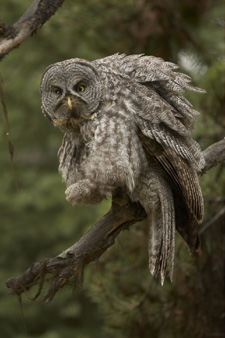 This year we had some
of the best luck we've ever had with GREAT GRAY OWLS, and both
groups did quite well. Mary found the first owl for our first
trip, and because we had been there first we were able to establish
some type of crowd control and group cooperation as more and more
photographers arrived. We had timed that owl search for a cloudy
day and we got lucky - we had the owl and we had the weather for
contrast-free shots. We stayed with that owl for several hours,
and on one perch the owl cooperated by rotating a complete 360
degrees to provide a multiple of view and poses. From that perch
it flew to a beautiful lichen-covered limb before flying off to
another perch deeper in the woods, where we left it at peace.
For our second week Mary spotted another owl on her side of the
road (we split up to search several different fields), and this
owl was perched on a low snag in an open field in complete sunlight.
Unfortunately another photographer had been working the owl before
we arrived, and this aggressive individual moved too fast and
pushed too hard, spooking the owl off the perch before our group
could assemble. The owl flew to another perch, and this photographer
simply walked in front of our group as he raced to a new position.
Later, one of our participants heard him say that our group was
just a bunch of tourists, so I guess it didn't matter to him.
This year we had some
of the best luck we've ever had with GREAT GRAY OWLS, and both
groups did quite well. Mary found the first owl for our first
trip, and because we had been there first we were able to establish
some type of crowd control and group cooperation as more and more
photographers arrived. We had timed that owl search for a cloudy
day and we got lucky - we had the owl and we had the weather for
contrast-free shots. We stayed with that owl for several hours,
and on one perch the owl cooperated by rotating a complete 360
degrees to provide a multiple of view and poses. From that perch
it flew to a beautiful lichen-covered limb before flying off to
another perch deeper in the woods, where we left it at peace.
For our second week Mary spotted another owl on her side of the
road (we split up to search several different fields), and this
owl was perched on a low snag in an open field in complete sunlight.
Unfortunately another photographer had been working the owl before
we arrived, and this aggressive individual moved too fast and
pushed too hard, spooking the owl off the perch before our group
could assemble. The owl flew to another perch, and this photographer
simply walked in front of our group as he raced to a new position.
Later, one of our participants heard him say that our group was
just a bunch of tourists, so I guess it didn't matter to him.
At any rate, crowd control was a bit more difficult with this second owl, and although that photographer still continually changed positions he did so a bit more slowly and quietly, and he didn't push pass the shooting line that we had established. We certainly appreciated that, but I was annoyed when I later heard about his comments. Had I had the chance, I'd have liked to have suggested to him that he'd have a lot more luck if he moved more slowly and demonstrated a lot more patience. A friend who knew him said that he was a good shooter and 'good guy,' which I'm sure is true, but if so, I wish that he'd have been aware that his actions -- carrying a big lens and looking serious - can be mimicked by 'mere tourists' who see someone else acting in a particular way. I think it's far better to set an example of patience and courtesy to others, so that clueless on-lookers may indeed learn the right way to behave. It's our philosophy that one can get a lot done if everyone works as a group and cooperates, and furthermore, professional photographers or serious shooters should set a behavior standard that others can admire and emulate. Selfishness is not only rude, it also results in animals being pushed and flying off or fleeing, indicating that someone has pushed too hard.
Illustrative of our
philosophy is the wonderful experience we had with BIG HORN SHEEP
RAMS on our second trip.There's an area we know that occasionally
had a hidden bachelor herd of big horn rams and I'd hoped to hike
out to the spot one evening to scout it out for our groups. As
luck would have it, our shooting schedule was so filled that I
never had the free hour to do so -- we returned to the motel too
late each evening to do anything but unpack. Luckily, though,
one of our group spotted some rams one morning and our group made
the hike (about 2/3rds of a mile) to where we'd seen the sheep.
They had disappeared by the time we arrived but we found them
again along a hillside, and for the next three hours our group
slowly worked our way into the bachelor herd. The sheep completely
accepted us, and several times various rams walked by as they
changed positions. When we had finally had enough shooting all
the rams were lying down, calmly chewing their cuds as they gazed
out over the valley. We slowly moved out and the sheep didn't
stir - we had approached with caution and concern and we now left
with concern and respect, and the animals were completely unfazed
by our encounter.
American Pika, one of the cutest small mammals in the Park, were a bit reclusive this year, but a few of us managed to get a couple of series of this rabbit relative. Two years ago, in their habitat, I photographed a Pine Marten, and a friend of our's, last year, photographed a weasel capturing a pika in the same location. So you never know what may show up!
It had been several
years since we'd last seen, or photographed well, big horn sheep
rams and that experience was the highlight of the week for many,
including perhaps all two weeks for Mary and I. Other real highlights
- we photographed several new scenic locations - an overlook of
Grand Prismatic Spring, a waterfall we've driven passed multiple
times, the 'mute dog forest' that always delights us with the
incredible abstract landscapes, and some great pronghorns. We
found a new location for American Pika, a cute little rabbit relative,
that teased us with only a few shooting opportunities, and we're
seeing more and more mule deer each year. Each group saw black
and grizzly bears and wolves, and we shot both species of luck
with varying degrees, although I must admit that the Park rangers
and the crowds make quality bear shooting very, very difficult.
This year we brought along our own spotting scope for viewing wolves -- a Tasco 20-60X scope I cajoled my parents into buying me for a Christmas present when I was in the sixth grade! I had contemplated buying a new scope before the trip, something of a luxury considering we only use a scope once or twice during the week, and usually we just borrow one of the wolf-watchers scope to do that, but I checked out my old Tasco and felt that it would do the job adequately for the limited role. However, I did survey many scope users, and had the chance to look through a Zeiss, Swarovski, and Bushnell scope, and the optics in each were similar enough that I couldn't decide which might be the best. Interestingly, the Zeiss owner was the most enthusiastic endorser, and he said he's looked through every scope made and thought the Zeiss was not only the least expensive of the group but was also the best. I would be VERY INTERESTED in receiving any feedback or opinion about 'scopes, because I'm still toying with the idea of getting one for next year. Any feedback will be appreciated!
We didn't see any
moose, although there was a moose bull, cow, and calf seen in
an area we frequently traveled but the moose were always out early
and retreated into the woods before the light came up. This year
Yellowstone has been suffering a drought and although we hit the
peak of fall foliage, aspens were rather muted and those scenes
were a bit lacking.
In truth, Mary and I felt that this year's trips were, perhaps, the best ones we have had in the last several years. We had great luck but I believe the success of the trips were very much due to the patience and cooperation of our groups. Everyone cooperated wonderfully, everyone was very patient, and everyone had a positive outlook that resulted in a no-stress, positive attitude group that resulted in wonderful images. Thanks, everyone, it was our pleasure!
Next year's Yellowstone Fall Photo Tour, September 14-20, and 21-27, still has some openings, but if you're interested, please contact our office as soon as you can. If you'd like to see other photos, from previous trips, check out the trip reviews from 2005 and 2006 to get a real sense of what we'll find and shoot on these Yellowstone tours.
